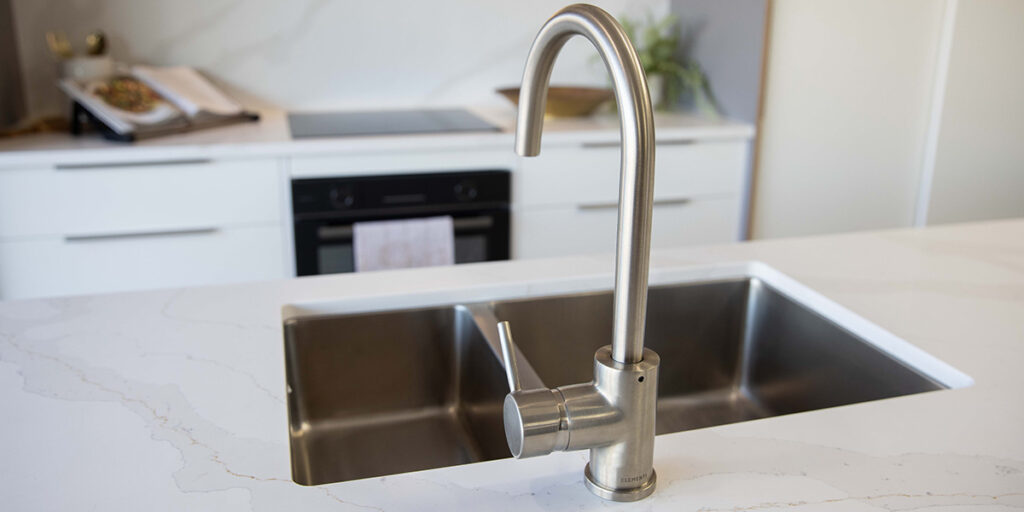How to Look After Your Kitchen Sink
Most kitchen sinks are made from stainless steel. There are grades of stainless steel, and this affects the durability and integrity of the sink over time.
It pays to check the gauge of the stainless steel when considering which sink to order. We recommend 18/10 304 stainless steel as a guide.
Over time, your kitchen sink will start to show damage from hardened metal utensils, pots and pans, and knives inadvertently dropped into the sink. Choosing a sink with the recommended gauge of stainless steel will ensure that your sink can better withstand the rough and tumble of kitchen use.
Your sink will develop a certain unique finish or patina over time as it is used. You can protect your sink with baskets and protectors. Ask your kitchen designer about these sink accessories.

Here are four simple steps to keep your sink in good condition over the years:
- To prevent food stains and chemicals from causing changes to the surface of your sink, use fresh water to rinse the sink out and grab a cloth to give it a wipe after use.
- After the last washing up every day, clean your sink thoroughly. Thoroughly rinse and wipe the surface with fresh water and a cloth, using a small amount of soft detergent. Rinse with fresh water and dry off.
- If you see staining or marks beginning to appear, use a soft cloth with baking soda and vinegar or lemon to carefully wipe until the marks disappear. Rinse off with clean water and towel dry.
- Once a month, give your sink a deep clean. Use a specialised stainless steel polishing cream on a soft cloth and rub it over the surface of the sink and into the corners. Rinse with clean water and towel dry.
Try to avoid scratching and other damage by following these steps:
- Use a bowl protector or drainer basket inside the sink, especially if you are doing something that is likely to scratch your sink. For instance, when draining shellfish, placing an old T towel on the bottom of the sink will prevent inadvertent bumps or scratches.
- Be very careful with large knives, as dropping them into a sink at the right angle can pit the bottom of your new sink. Place hard utensils softly into the sink at a more horizontal angle. Never throw utensils into a sink.
- Always use soft cloths or sponges, and avoid using wire scourers or wire brushes to clean your sink.
- Avoid using harsh chemicals like spray and wipe products. Stick to environmentally friendly bicarbonate soda or similar products, along with vinegar or lemon juice.
- If you must use bleach or harsh chemicals for hygiene reasons, make sure you rinse them off thoroughly with fresh water. While stainless steel is a durable product, it can still be penetrated by very harsh chemicals that can undermine the surface shine. So, rinse thoroughly with fresh water and dry off.
- Don’t leave food scraps or dishcloths laying on your sink, as they can cause stains or pits in your sink as they release their chemicals. This may affect the shine over time.
- Hang your cloth up to air and keep your sink clean and dry between uses, and it will look like new for a very long time.
What causes the small marks to form on my sink’s surface?
Often, these marks are limescale deposits caused by hard water. The limescale gathers dirt, making the marks visible. Small marks can also result from iron and rust particles washing from your water pipes, especially if they are very old or galvanized, or from cast iron pans sitting in your sink. Marks can also result from bleach, salt, and citric acid sitting on your sink’s surface. All marks are easy to clean with a damp, soft cloth or gentle vinegar or lemon-based cleaner. Rinse with clean water and towel dry after cleaning.
How can I stop marks from forming on my sink?
Rinse your sink clean after every use and wipe it dry with a soft cloth or towel. If a mark appears, don’t be tempted to scrub it away. Wipe it with a damp, soft cloth and gentle cleaning agent or apply a stainless-steel polish.
Why has my stainless-steel sink scratched after only a few weeks of use?
Hardened metal utensils, food processor blades, and pots and pans will slightly scratch your sink’s surface. Over time, with normal use and wear, the scratches appear to vanish as your stainless-steel sink develops its own unique finish.
Is my stainless-steel sink rustproof?
Yes, stainless steel is engineered not to rust. Any rust marks that appear on your sink’s surface are typically transferred from other metals that have touched your sink. Should this occur, remove the mark by wiping the sink with a damp, soft cloth or applying a non-abrasive stainless-steel polish. Don’t leave scourers sitting on the sink or tray surface, as these scourers deteriorate with water and air, leaving stains that can be difficult to remove.
How can I clean my basket strainer?
Your basket strainer works hard to prevent your sink from clogging, but it may soil and discolour over time. To clean your basket strainer, combine a level teaspoon of dishwashing powder with 250 ml of boiling water and pour it over the closed strainer. Leave the solution to work and then rub it with a soft cloth. Open the basket strainer to drain, and then remove the strainer and wipe the drain cup.
If you want to know more, get in touch, and we can recommend the best sink for your new kitchen.



